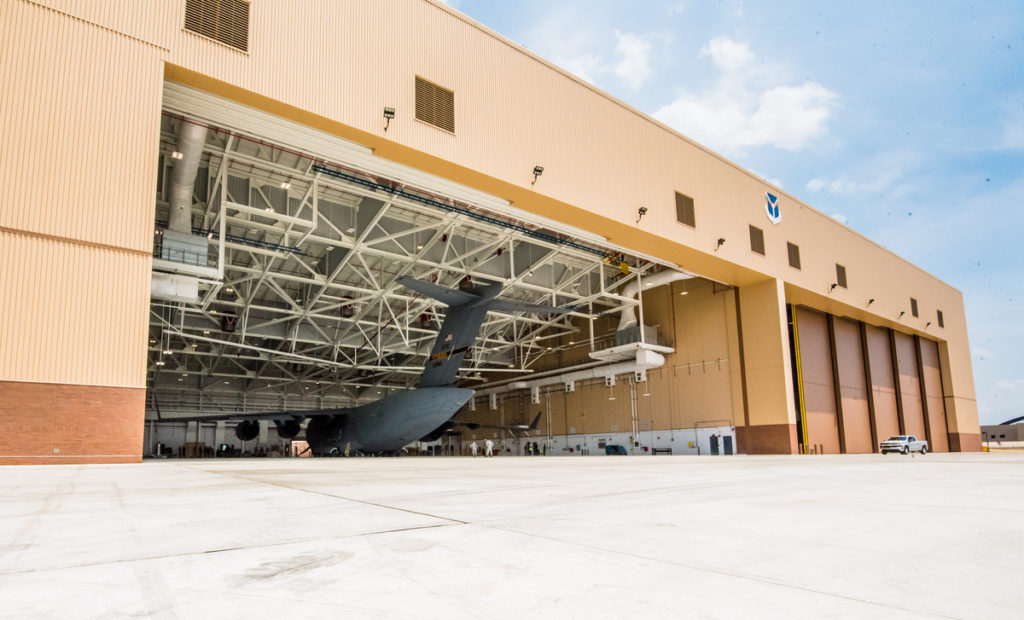New Aircraft Secures Future for 911th Airlift Wing
Pittsburgh’s Air Force Reserve Station opens new hangar on base as C-17s roll in
By Natalie Fiorilli
Published June 8, 2020
Read Time: 4 mins
On June 4, airmen from the 911th Airlift Wing gathered to watch as crews towed a C-17 Globemaster III aircraft into a just-completed two-bay maintenance hangar on the base.
For an Air Force Reserve station, this may seem like a routine occurrence. But for the 911th, the hangar opening marked an important milestone.
In late May, the airlift wing officially completed construction of the new, two-bay hangar, which will allow airmen to safely perform maintenance on C-17 Globemaster III aircraft. A nearly three-year project, the 911th initially broke ground on the hangar in November 2017.
The new hangar is part of the base’s ongoing conversion process – in 2018, the 911th began phasing out its C-130 aircraft to welcome a fleet of eight newer and larger, C-17s.
“This is a huge project for the base as we transition from the C-130 to the C-17,” said Col. John F. Robinson, commander of the 911th Airlift Wing, as he watched the airmen tow the roughly 175-ton military plane into the hangar.

Col. John F. Robinson, commander of the 911th Airlift Wing, discusses the significance of the hangar opening for the base’s conversion status. (Photo by Beth Hollerich)
“They can bring the [aircraft] in the hangar and out of the elements. Particularly in the winter, if we have a mission going out the next day, they can pull the aircraft inside overnight and protect it from snow so it’s ready.”
Ultimately, the new mission and arrival of new aircraft has secured the future of the base.
Years of uncertainty
In 2005, the 911th found itself on a list of Air Force bases threatened for closure in a Base Realignment and Closure (BRAC) report.
The report said the airlift wing, which at the time hosted eight C-130 Hercules aircraft, lacked room for growth to accommodate additional aircraft. And while ultimately the BRAC Commission decided to keep the base open, the future of the airlift wing was not guaranteed.
What followed was years of uncertainty for the 911th. In those years, the Military Affairs Council of Western Pennsylvania and the Allegheny County Airport Authority worked to defend the base. Additionally, the Airport Authority extended the lease to the base with additional acreage to help secure the new mission. The rare civilian-military partnership means cost savings as well.
“Throughout this entire process, we have been proud partners with the 911th and are excited to support their new mission,” said Vince Gastgeb, vice president of government and corporate affairs for the Airport Authority. “We knew that with the bigger aircraft, they would need more space and that there would be infrastructure upgrades to the base, including the hangar, and we’ve been happy to do our part in supporting them.”

The two-bay hangar can store two C-17 aircraft at a time, allowing crews to perform necessary maintenance and inspections away from weather. (Photo by Beth Hollerich)
Eventually, Congress went on to award funding to the 911th for upgrading the base in 2016 to handle the C-17 Globemaster III aircraft. Today, the airlift wing houses a total of eight C-17s.
Strategic role
The C-17 is a more modern and multifunctional aircraft and has an ability to land on short and narrow runways. Because of this, C-17s are used for a variety of missions, including airlifts, hauling large equipment and supplies and even transporting ambulatory patients. The aircraft can handle payloads as large as 85 tons.
The addition of C-17s means quite a few changes for the base: training for pilots, maintainers and other crews, new facilities on base and ultimately, an entirely new mission for the 911th.
“The C-17 is just about twice the size of the C-130,” Col. Robinson said, noting that in comparison to the C-130, missions on the C-17s are more “strategic” than they are “tactical.”
“With the strategic role and the legs of the C-17, we don’t do what you would call a typical deployment,” Col. Robison explained. “With the C-130 it would take about five days to get to the Middle East and they would stay there for about 120 days. The C-17 can be there in 16 hours – so with the legs that it flies, usually missions are 1-8 days.”
For Marcel Minutolo, board chair of the Military Affairs Council, seeing the C-17s flying around Pittsburgh brings a sense of pride and excitement for the region.
“It’s just amazing seeing and listening to these aircraft fly overhead,” said Minutolo. “The plane is amazing, and it’s an incredible piece of machinery. It’s exciting to see all of the activity going on and now, the hangar is open.
“For Pittsburgh this means economic impact, it means job security for many and it brings more visibility to the region.”
Watch
This Next
Read
This Next





